Mostar is one of the most visited towns in Bosnia and Herzegovina. Often people go for just a day trip but I recommend spending at least a few days there. Mostar is best known for its picturesque Stari Most bridge and Ottoman Old Town but there is much more to see. It has interesting street art, scars from the war, and beautiful surroundings. There is also a great day trip option to a gorgeous waterfall and a medieval and Ottoman-era fortress village. This post share the sites in and around Mostar that we recommend from our visit in May 2025.
To get to Mostar we took a 2 1/2 hour bus from Sarajevo. Incredible scenery along the route made this a fun bus journey. The Prenj Mountains and Lake Jablanica were a couple highlights we passed on the drive.
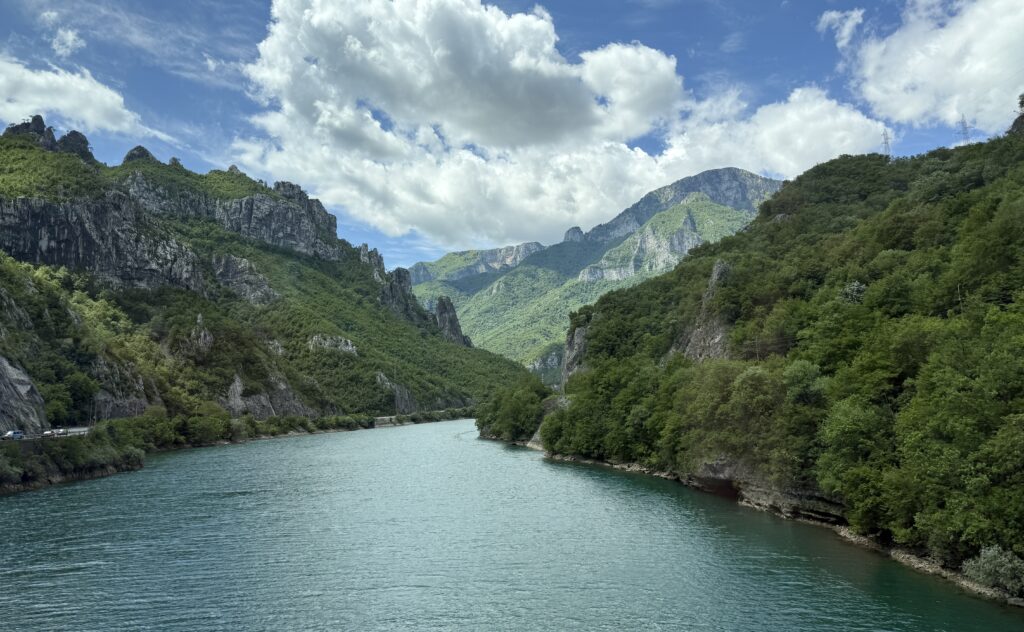
Stari Most
The most famous site in Mostar is the Stari Most (Old Bridge). Stari Most is a single arch, stone bridge that connects the two parts of the city across the Neretva River with fortified towers on each side. This Ottoman bridge was built from 1557 to 1566. It is 30 meters across and 24 meters high. At the time of its construction Stari Most was the widest human made arch in the world.
After spanning the river for over 400 years, Stari Most was destroyed in 1993 during the Croat-Bosniak War (part of the Bosnian War). It was rebuilt in 2004 using the original stones.
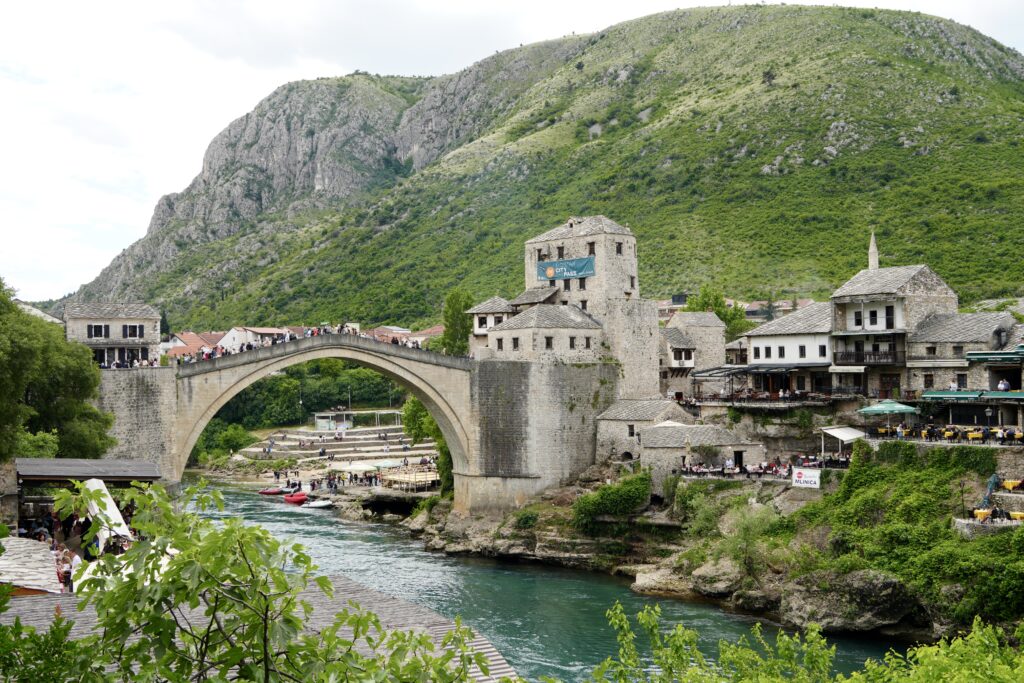
Young local men collect money to jump from the bridge to the frigid river water below. Once they collect enough, one of them will make the jump and swim to shore. People have been jumping from the bridge since the mid 17th century and since 1968 an annual bridge jumping competition is held each year in late July. The bridge has been a stop on the Red Bull Cliff Diving World Series.
A nice view of the Old Bridge can be found from the west banks of the river just south of the bridge. If you visit early in the morning you might get the viewing area and the bridge all to yourself. By mid-morning the bridge will be packed with tourists.
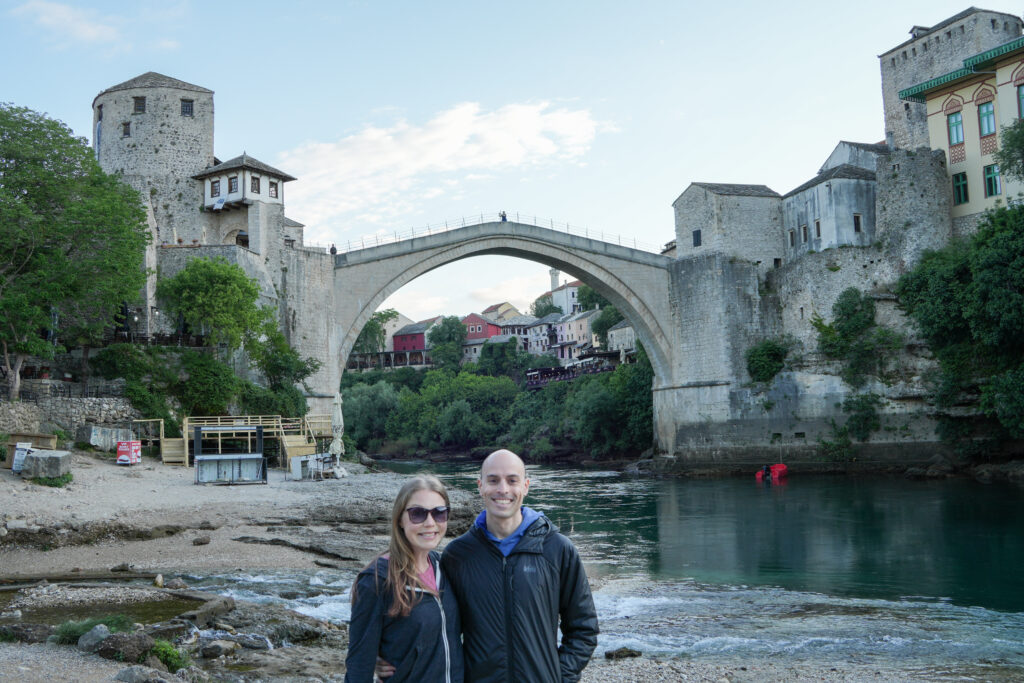
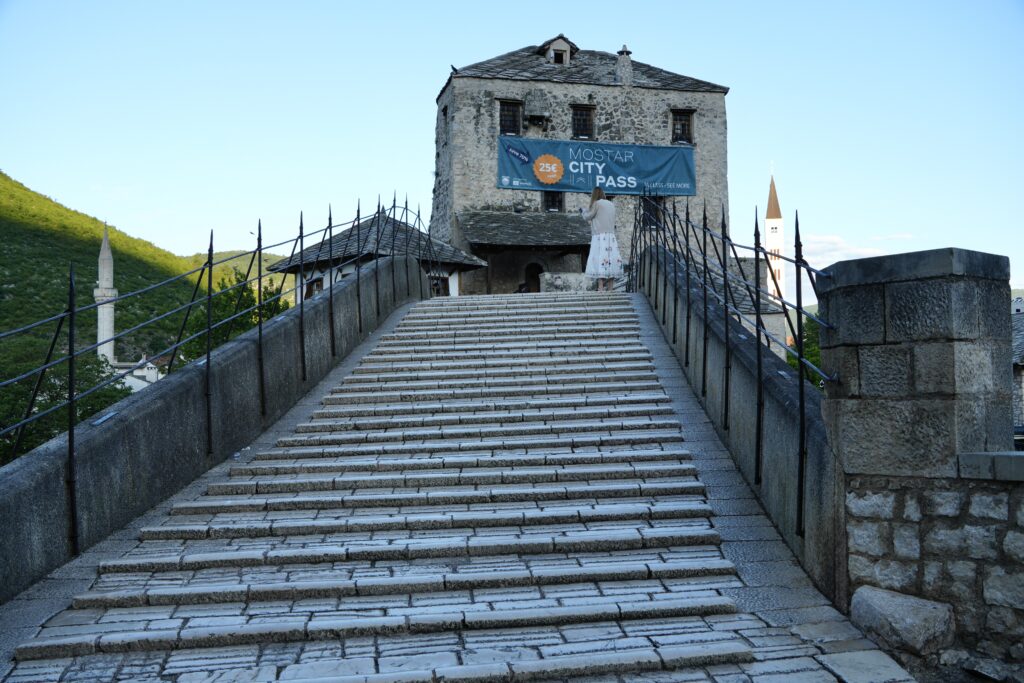
Mostar’s Old Town
Old Town spans out on each side of the Stari Most bridge. The city of Mostar developed in the 15th and 16th centuries and Old Town is full of Ottoman style architecture. Narrow pedestrian cobblestone streets weave through one to two story, stone buildings. I found the slick, bulbous cobblestone to be challenging to walk on. They are quite slippery especially after a rain shower. Like the bridge, this whole area was damaged during the war but has been restored.
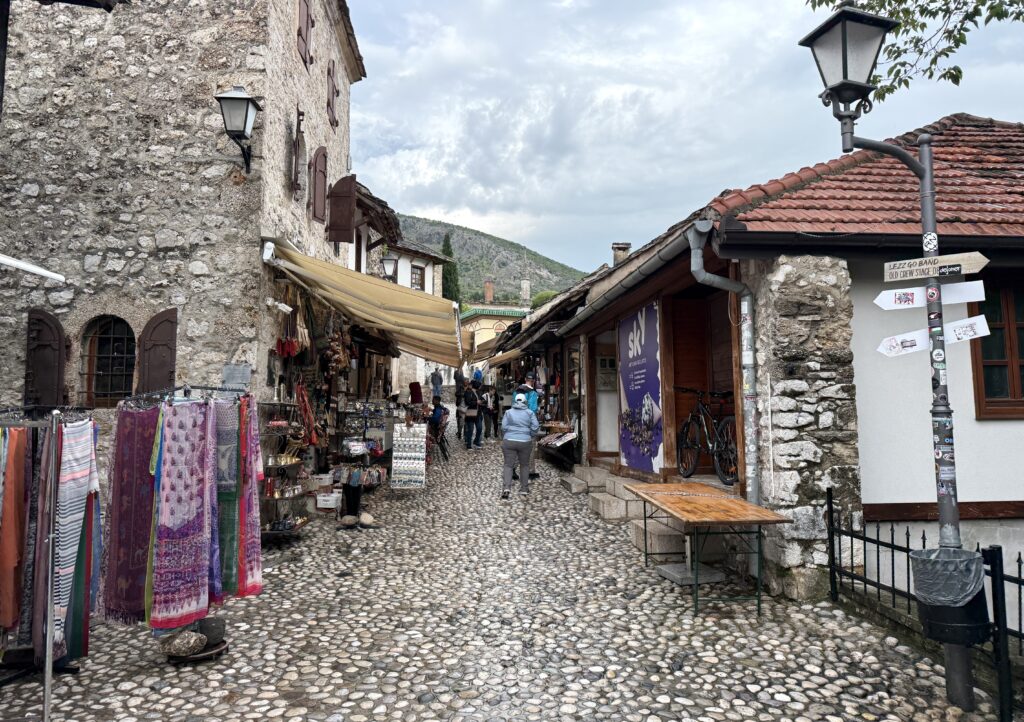
Today almost every building in Old Town is filled with souvenir shops and restaurants. Souvenirs are set out in front of the shops each morning in an attempt to lure the mass of tourists that arrive each day in for a purchase. So many people come here on day tours that the narrow streets get packed and it becomes challenging to move through them. I strongly recommend spending at least one night here to wander this idyllic setting when it’s nearly deserted in the early morning or later evening.

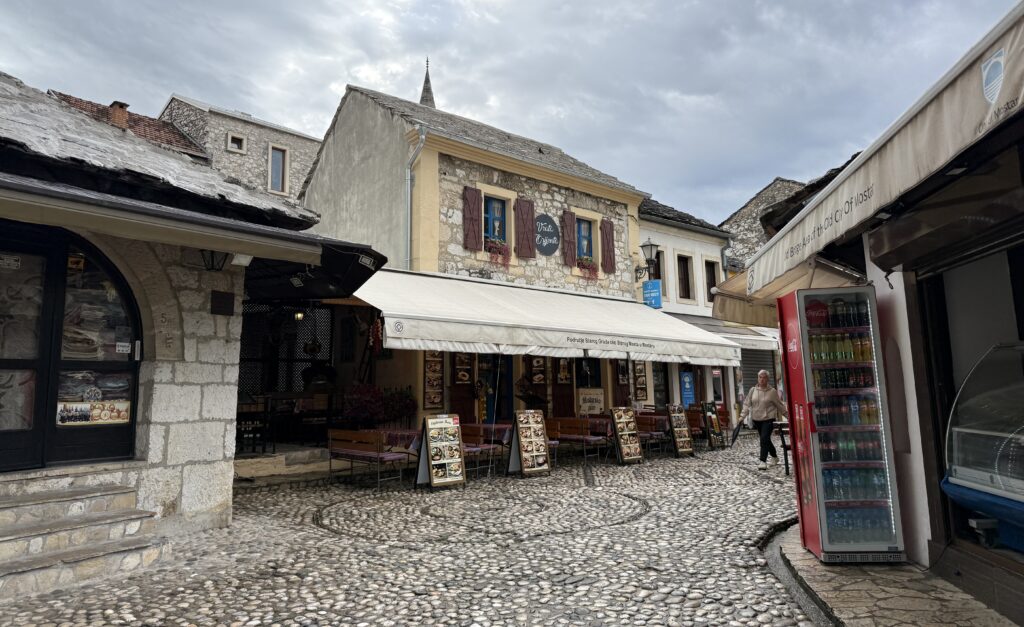
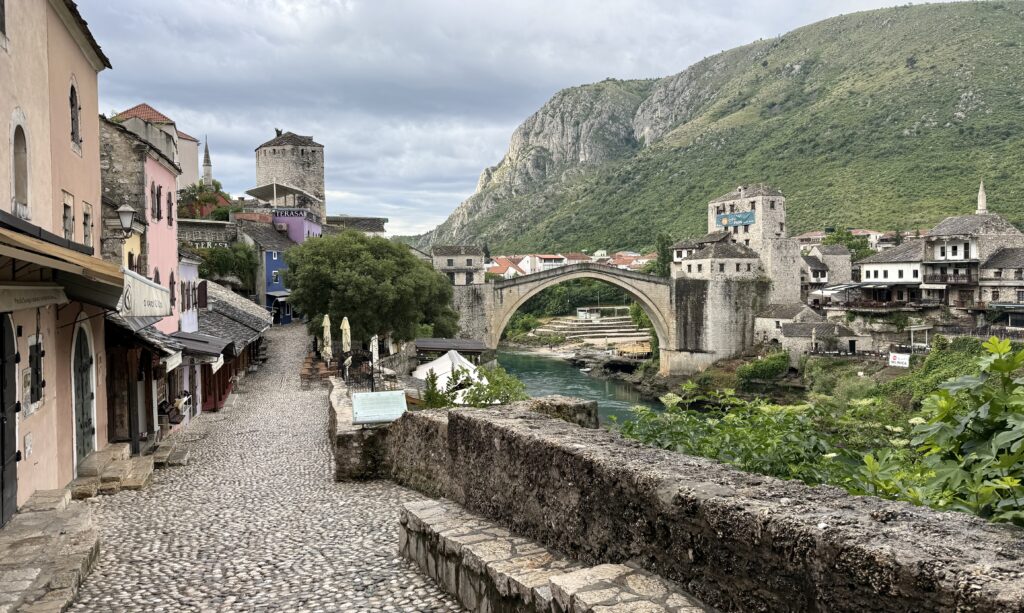
Cute restaurants fill terraces along the Neretva River as well as a smaller river that feeds into the Neretva. West of the Neretva River in the Old Town stands the Crooked Bridge, a smaller charming bridge with a similar style to Stari Most.
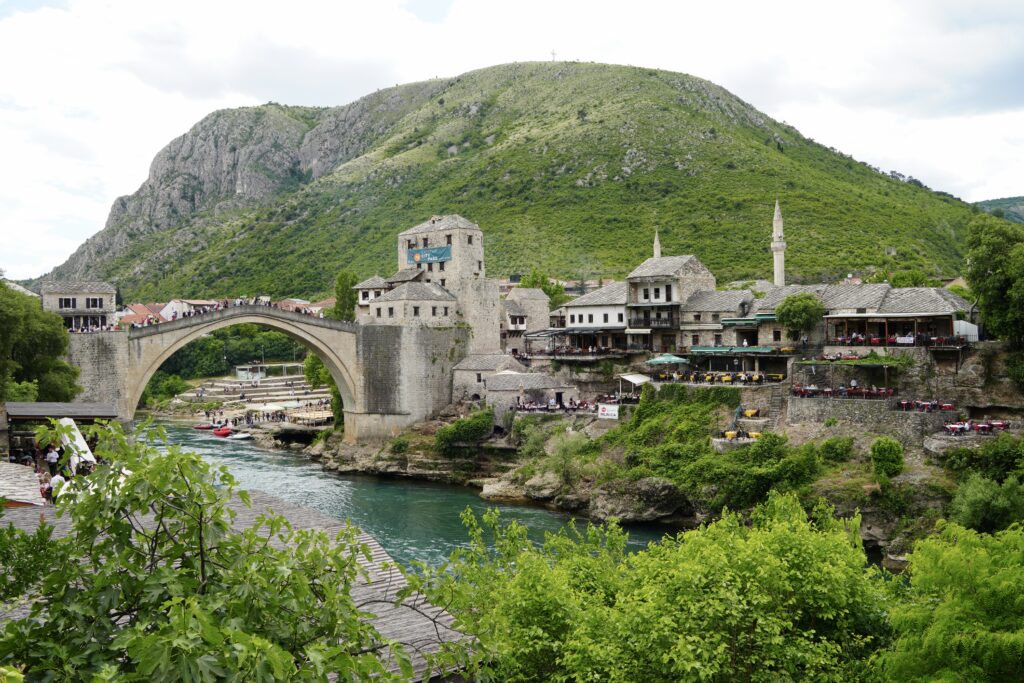
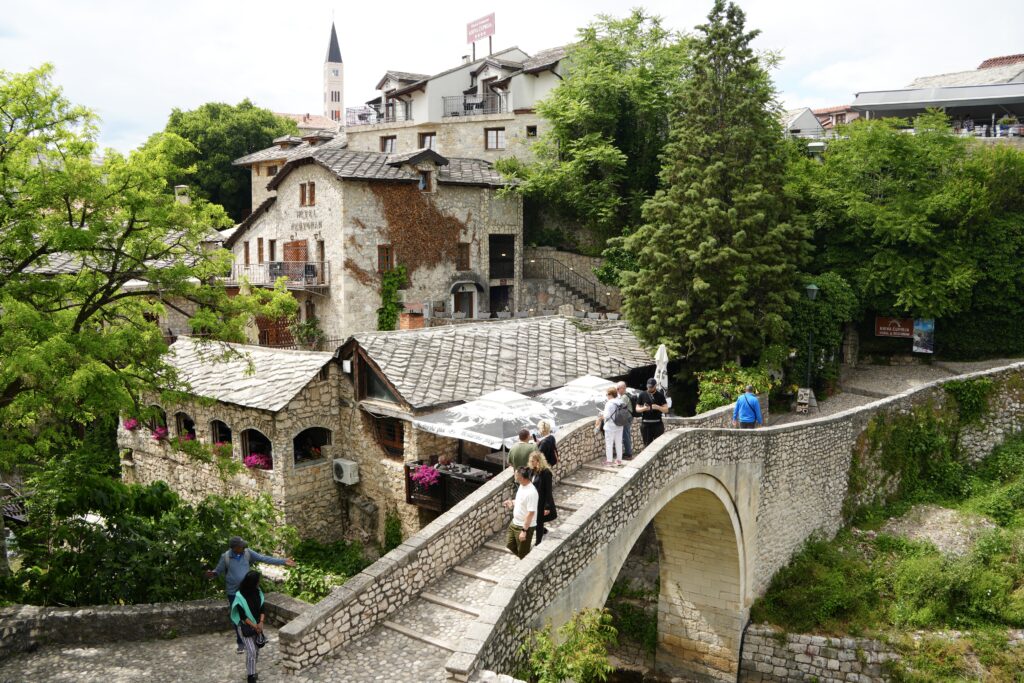
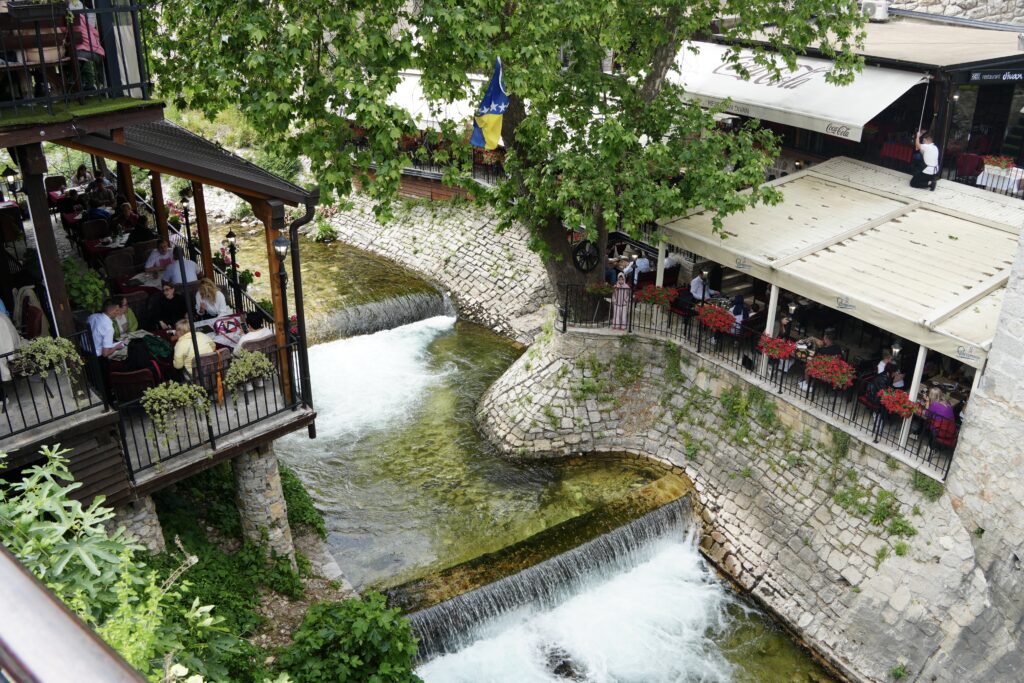
The Old Town contains a couple of mosques. The Koski Mehmed Pasha Mosque is next to the river and you can pay to enter it and see the view from the backyard and up in the minaret. It should be a nice view of the Stari Most bridge, but we didn’t pay to enter. The Karaðoz Beg Mosque is on the north edge of Old Town and has a small Muslim cemetery next to it. This mosque is easier to photograph.
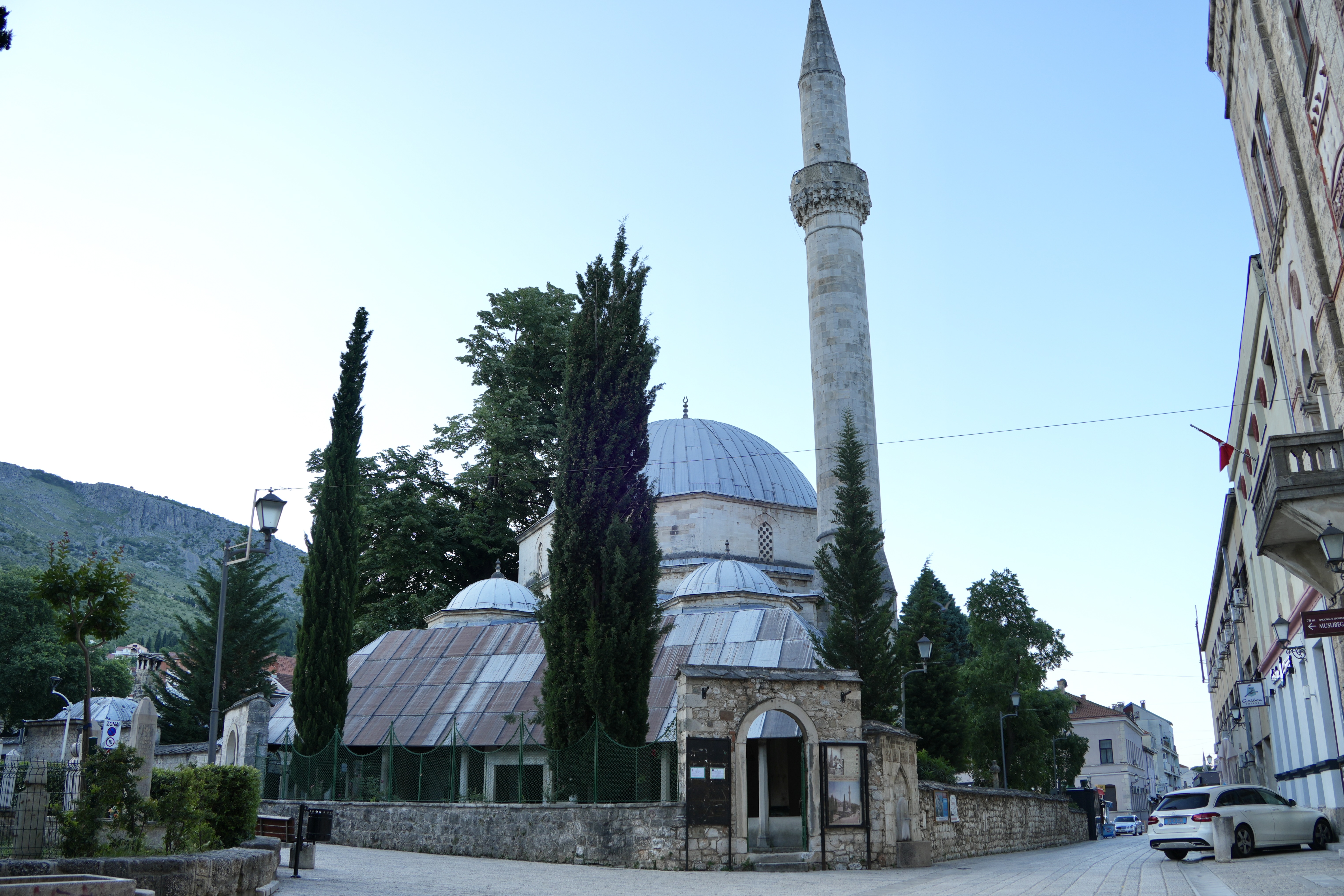
Mostar Gymnasium
The architecture of the Mostar Gymnasium makes it a worthwhile building to visit. It is called a “gymnasium” but it’s a historic secondary school, not a place of physical exercise. The word gymnasium in much of Europe refers to a type of school that prepares students for university. During the Austro-Hungarian rule of this region, a new style of architecture emerged in the region called Moorish Revival Architecture. The design came from the Islamic styles of Spain and Northern Africa rather than the previous Ottoman Empire of this area. The Austro-Hungarian Empire used this architecture as a way to create a unique sense of identity not associated with the previous Ottoman Empire or the growing pan-Slavic movement. Construction of the building finished in 1902. Another example of this architecture is the Hotel Neretva which was destroyed during the Bosnian War and is still being reconstructed.
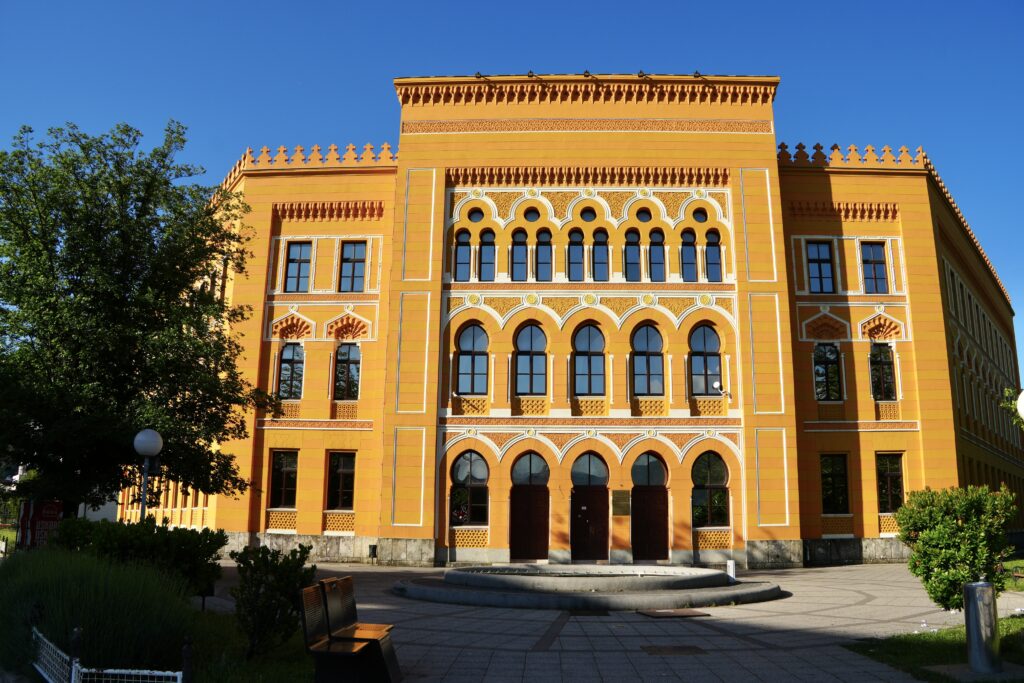
Franciscan Church and Peace Bell Tower
The Franciscan Church and its “Mostar Peace Bell Tower” are also worthwhile to visit. The bell tower is 107 meters high and is said to offer a great view over the city. We didn’t pay to go to the top of this but we did visit the inside of the church which was free and really beautiful. The current building was built in a new contemporary design on the foundations of the original church that was destroyed during the Bosnian Wars. The front of the white church has a simple curved top with concave topped buttresses swinging out on each side. The single skinny bell tower reaches dramatically into the sky on one side. I was most impressed by the ambiance inside the church. Shimmering frescoes of gold, yellow, and orange cover the inside walls.
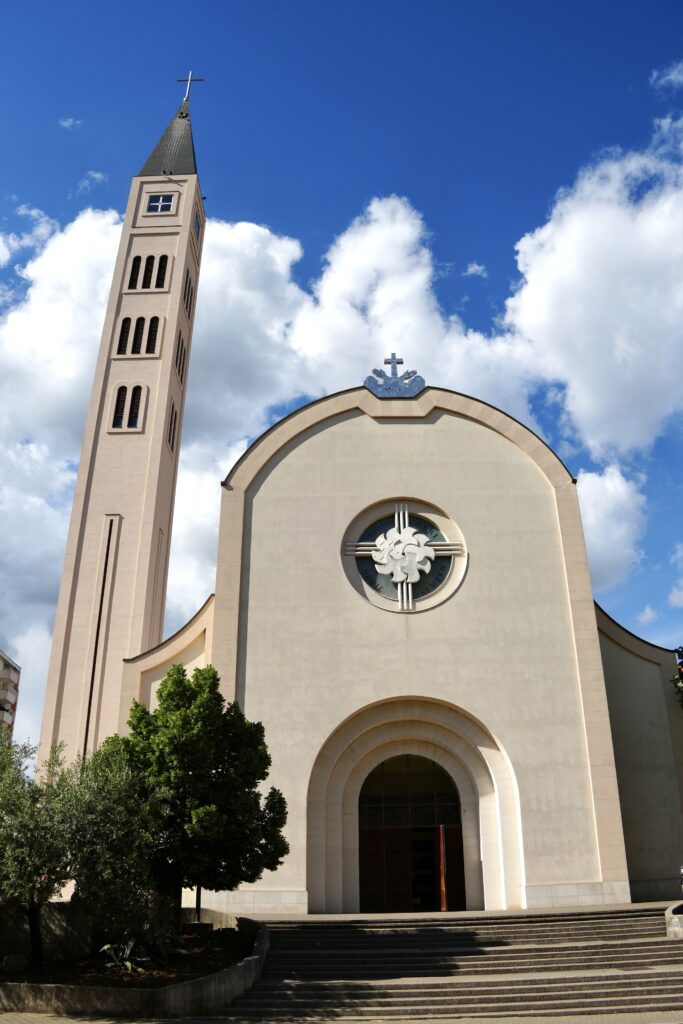
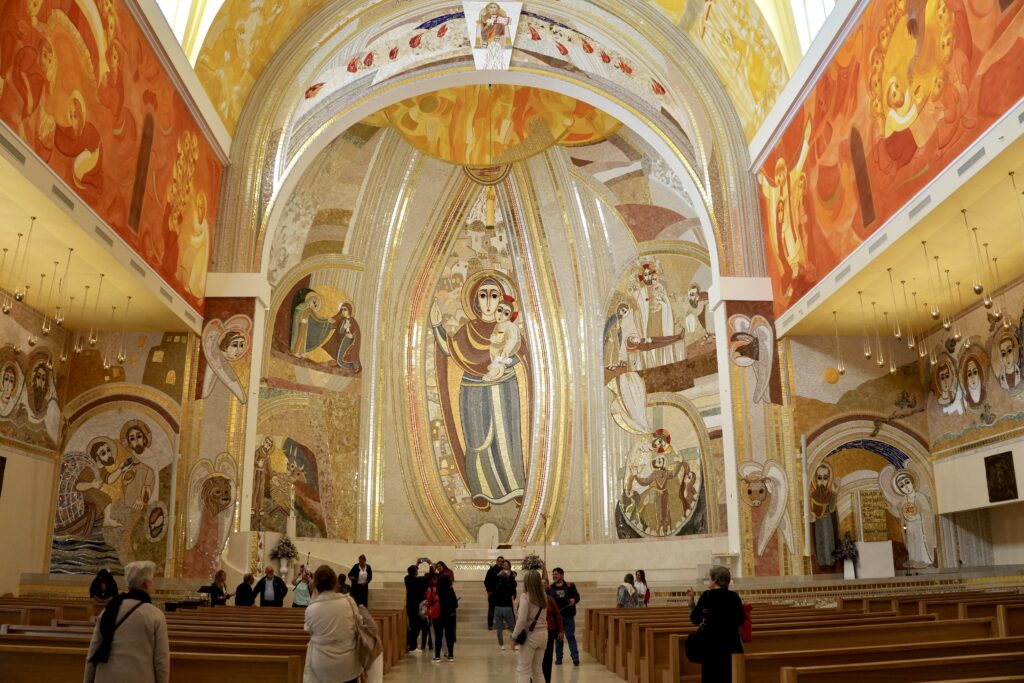
War Scarred Buildings
Derelict ruins of buildings are scattered around Mostar. Much of the city has been repaired since the wars, but quite a few buildings still stand devastated. Some of the ruined buildings have green plant life taking over creating a post-apocalyptic image. Others are still functional but covered in bullet holes.
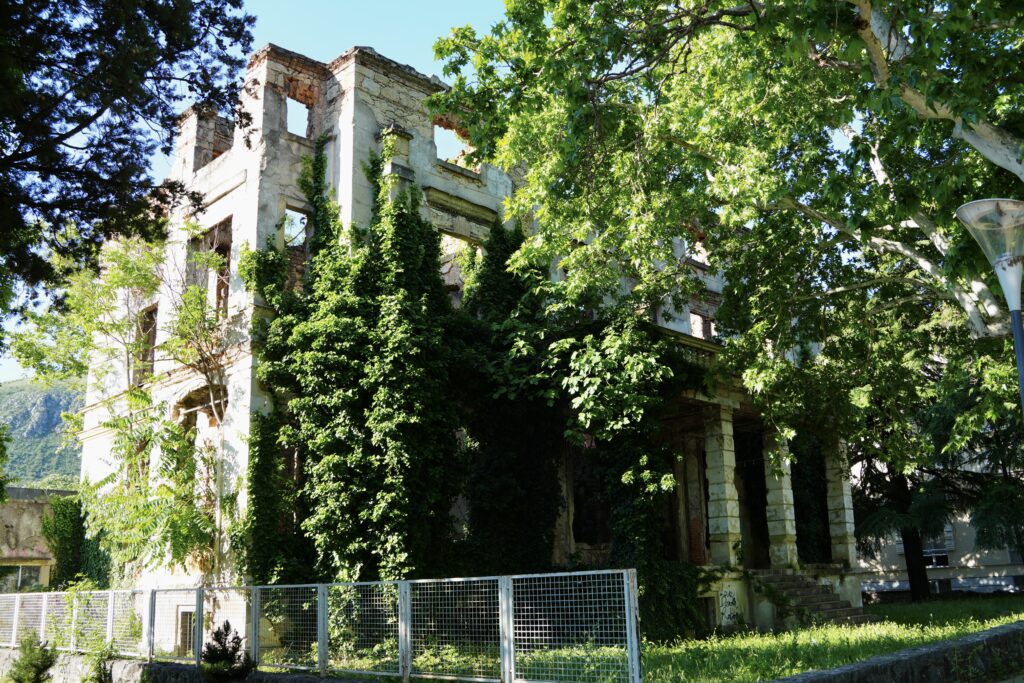
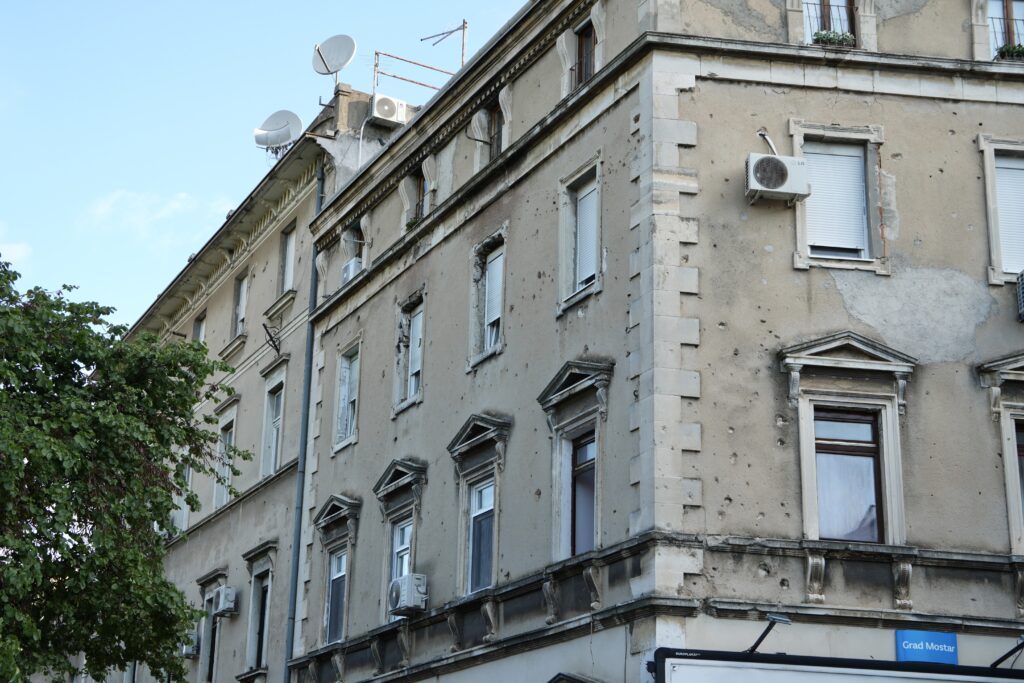
Street Art
Murals add a more modern and artistic flare to the city. This art is being used to express a hopeful future for the youth of Mostar. Artwork is spread out around the city, but the easiest to find is that on the west side of the river, north of Old Town. The highest concentration of murals we saw was on Alekse Šantića Street which turns into Tvrtka Miloša Street. The wall in front of Zatvor U Mostaru Prison was covered in artwork.
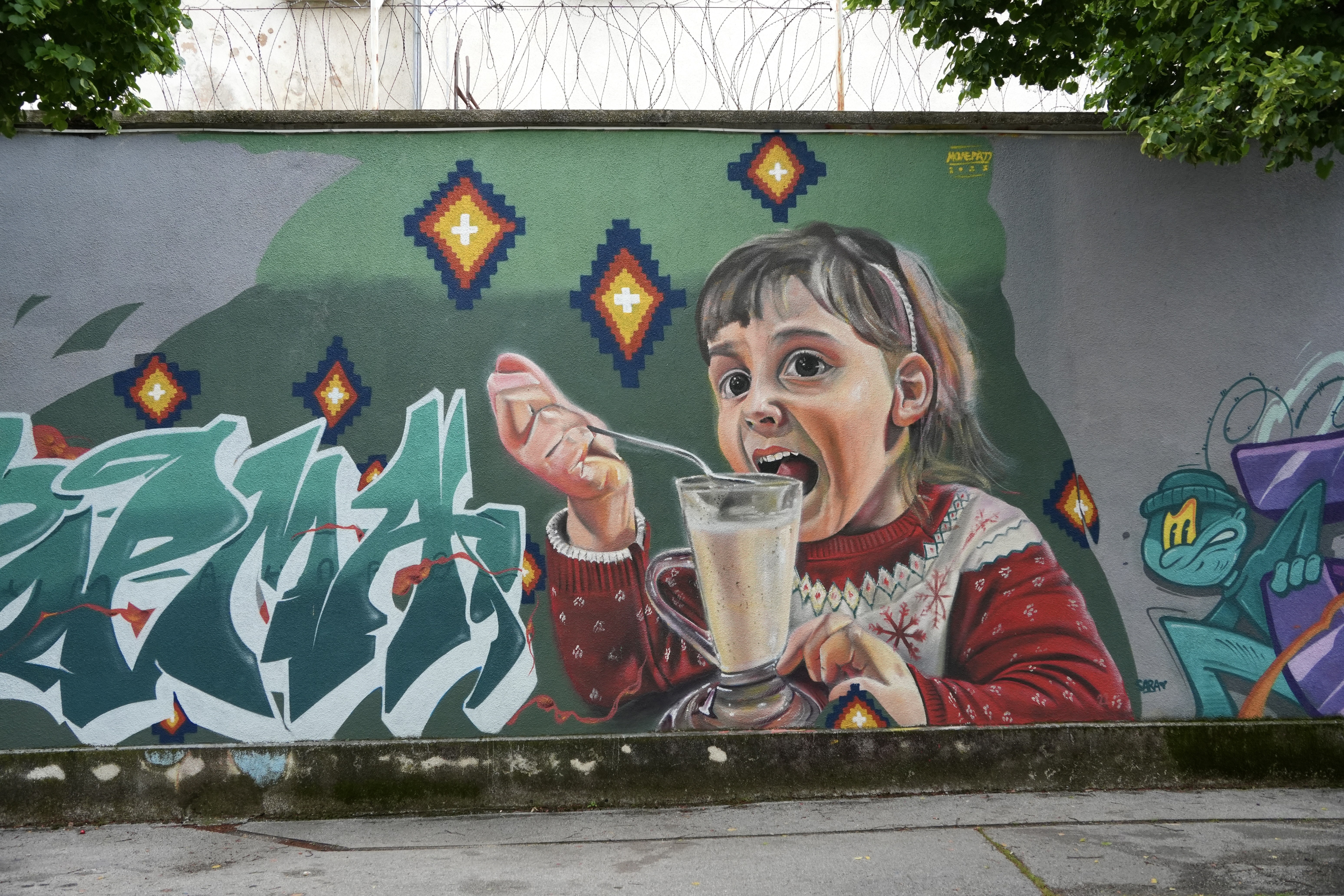
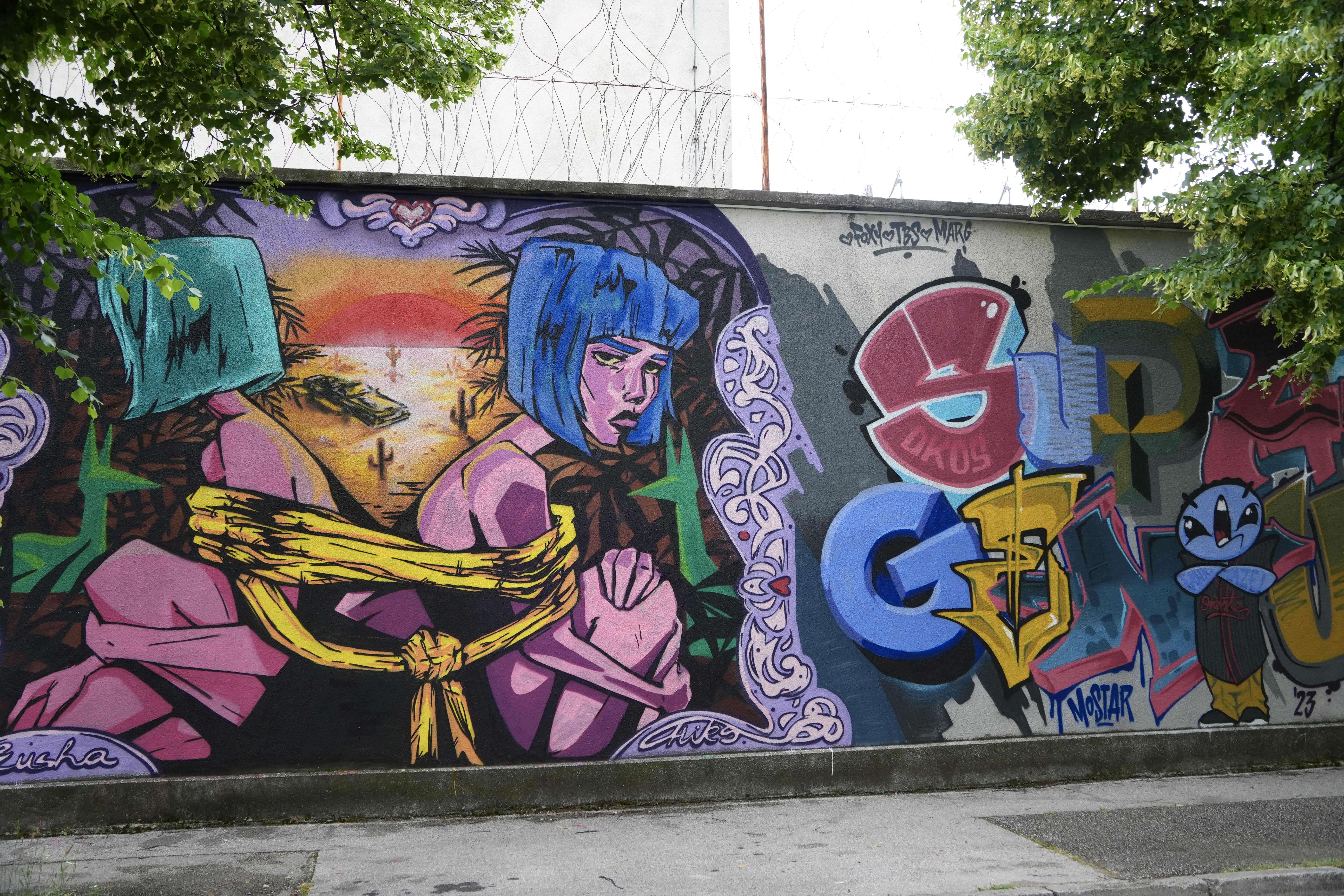
More murals can be found by wandering through the maze of buildings on the north-east side of Tvrtka Miloša street. Murals cover the facades of many of these homes.
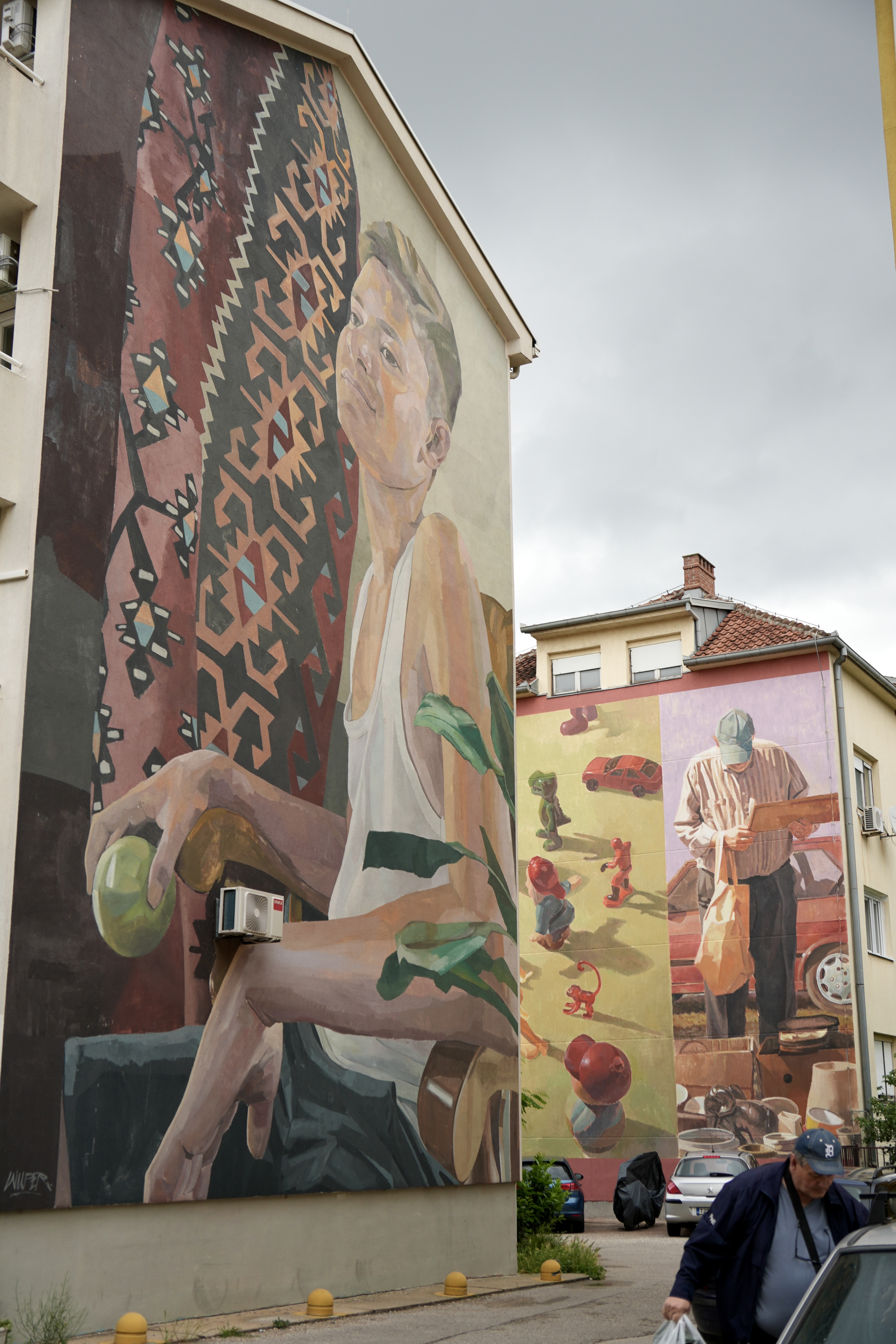
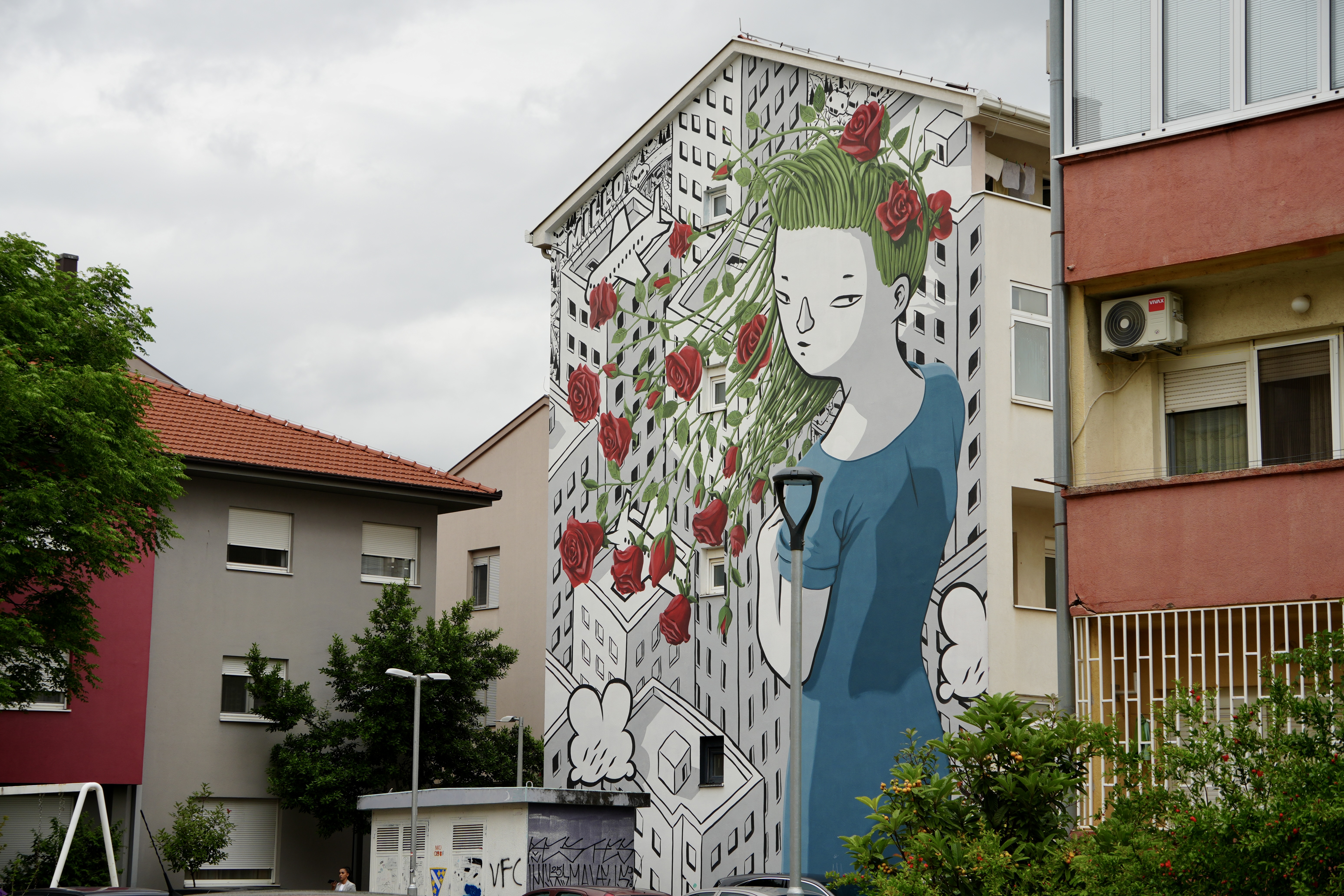
Another nearby area to checkout is the old sniper building found where the Kneza Domagoja and Kralja Zvonimira streets come together. This tall building was built to be a bank, but the war began and it was used as a sniper tower. The sniper tower has lots of interesting artwork on it as well. The bullet holes from the war add extra character to the some of the art. My favorite was the mural that seems to depict an army-green war machine destroying a city.
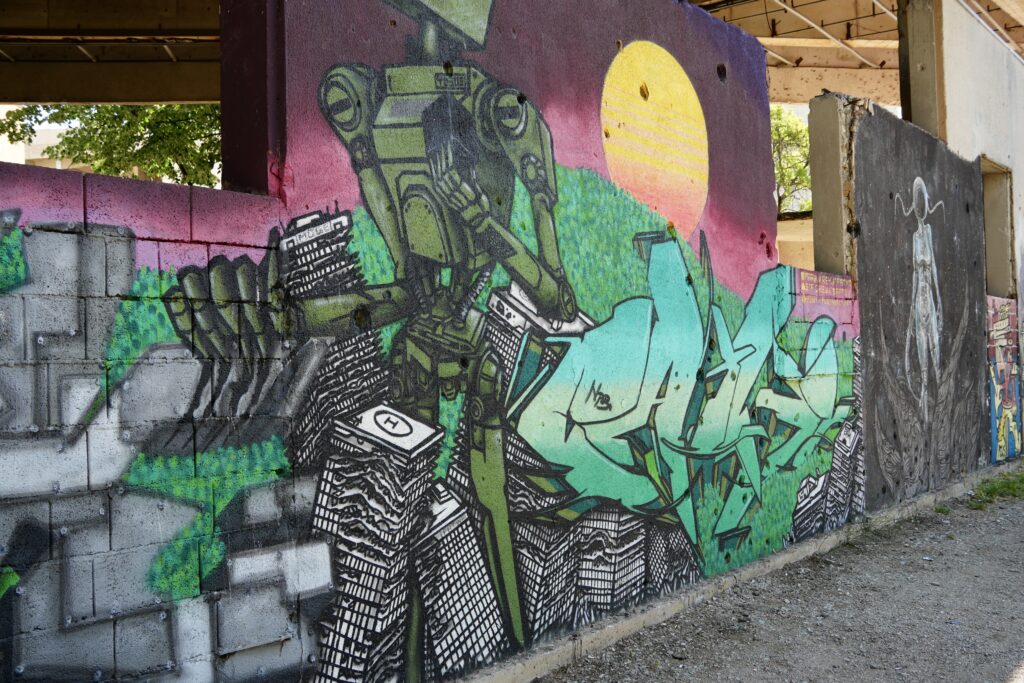
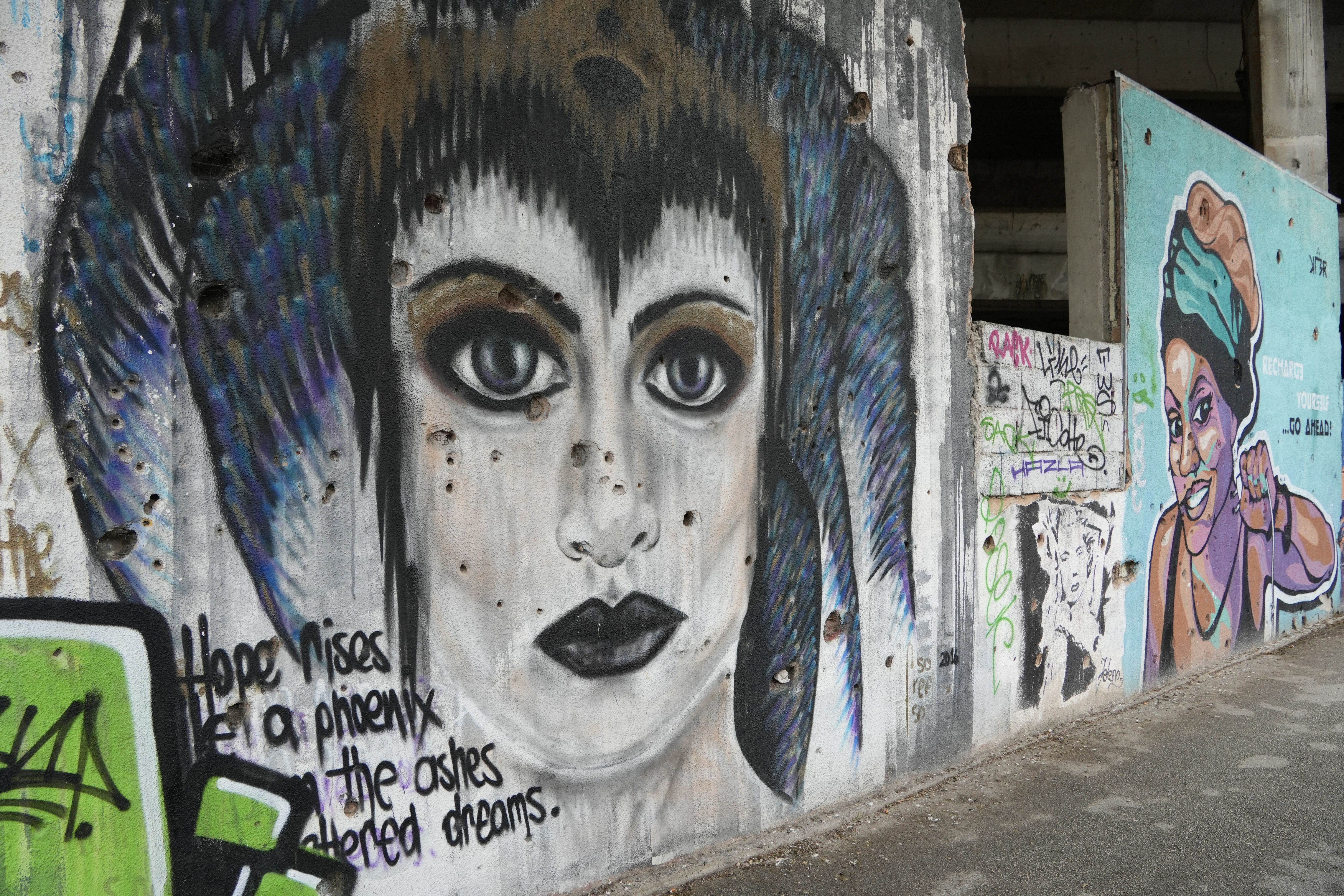
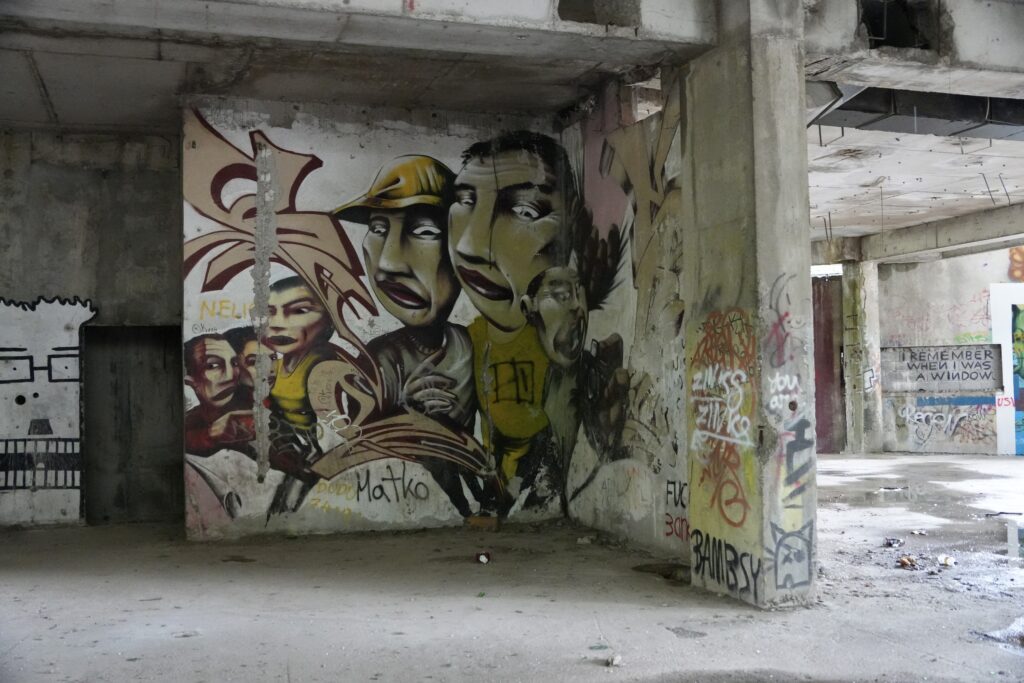
WWII Memorial
A really interesting WWII Memorial was created in the western part of town. Sadly it is not being maintained and you will find some of the stones scattered and also some garbage. We still enjoyed wandering around it, but hopefully in the future it will be restored and taken better care of.
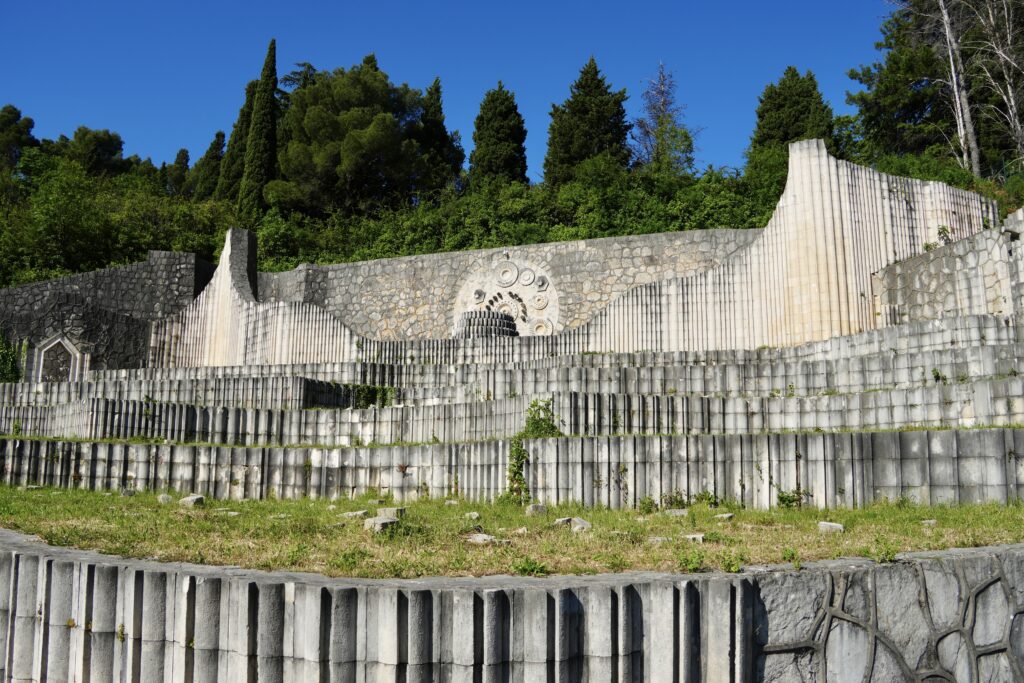
Gorgeous Natural Surroundings
Mostar is naturally gorgeous. The Neretva River rushes through the middle of town. Its tumbling ice-blue water and the lush green foliage along the banks is mesmerizing. Add to that the mountains that surround this historic city and it really is a joy to just go for a walk and look around.
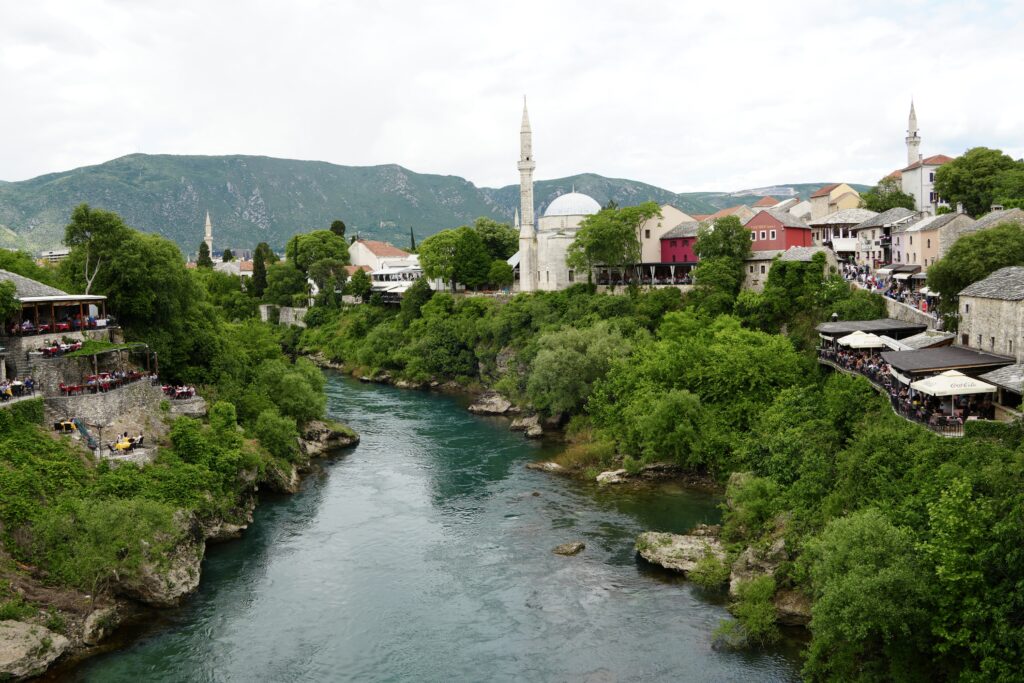
Day Trip to Kravica Waterall and Počitelj
Not far from Mostar is a dramatic waterfall that I really wanted to visit. I couldn’t figure out how to get there by public transportation, so we found a tour on Get Your Guide to join. I kept reading that the waterfall becomes packed with visitors by the afternoon (because all the tours show up then). I really wanted to beat the crowds so I found a tour that went to Kravica Waterfall first. When we arrived around 10 am almost nobody was there. The forecast showed rain all day so I think that helped scare off other tourists as well. It didn’t rain until the afternoon, so our plan worked perfectly!
The sound of rushing water increased as we walked down the trail. Soon we could see the curtain of rushing cascades filling a pool below us. It was awesome! We continued down the path to the edge of the water. The waterfalls were larger than we expected and we marveled at their beauty and power.
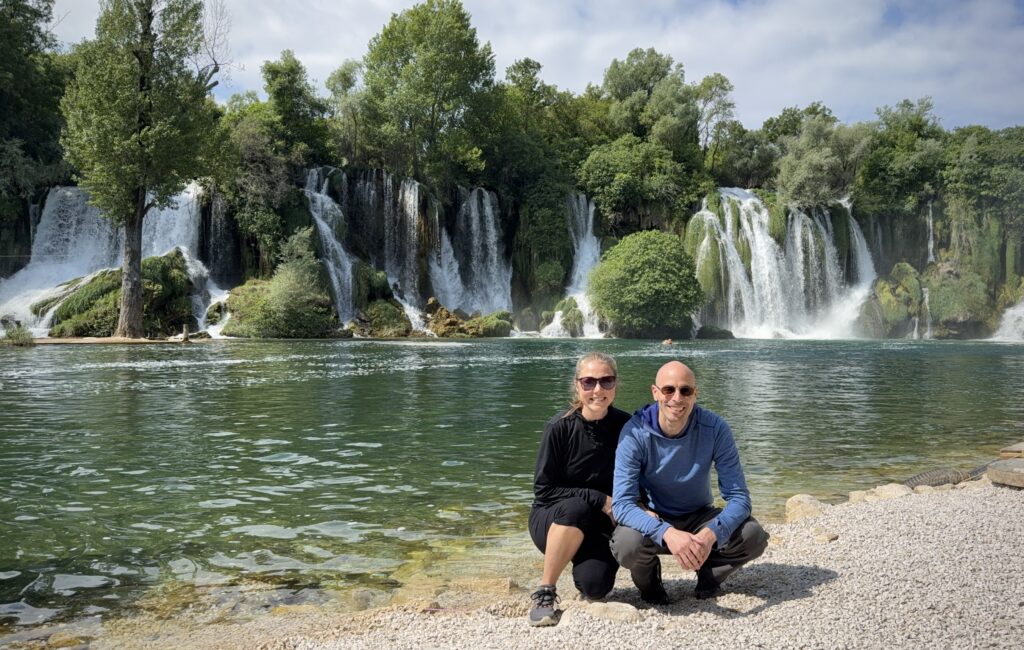
Restaurants are set up along the shores of the water to sit, relax, and enjoy the view over a drink or food. Swimming is also allowed in the water, but beware it is really cold! I managed to get myself in for a swim but it was too cold to stay in long.
After a few hours at the waterfall, our guide picked us up and we drove to the town of Počitelj. This town is visited for its medieval Ottoman architecture and hillside location overlooking the Neretva River. We only spent about 30 minutes here. We wandered around the old buildings, climbed the steps up to the old ruined fort and enjoyed the views over the landscape.
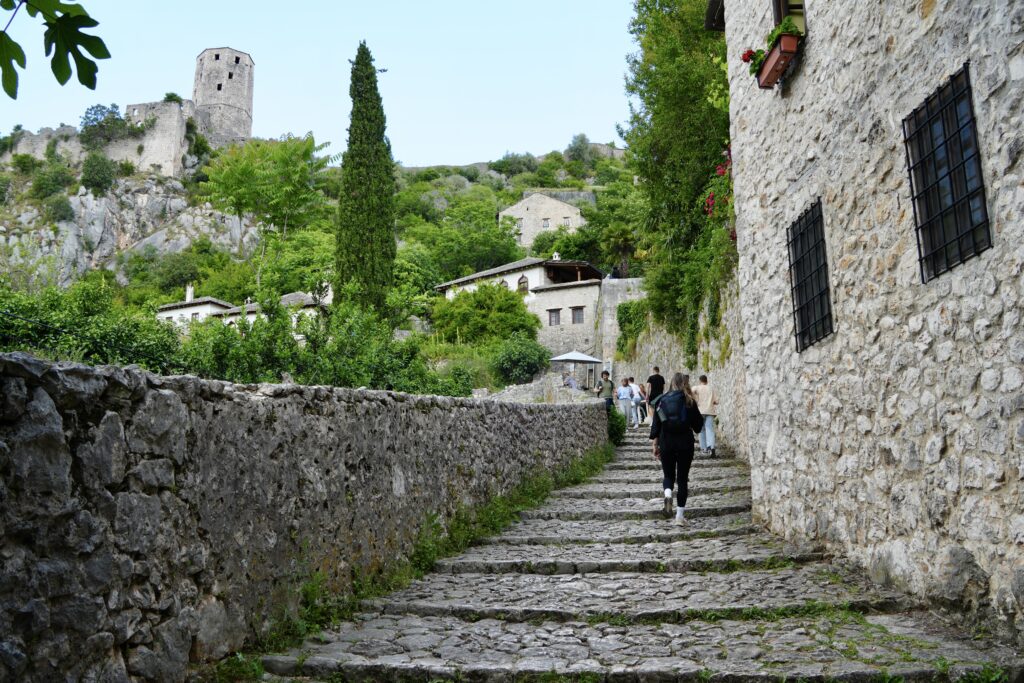
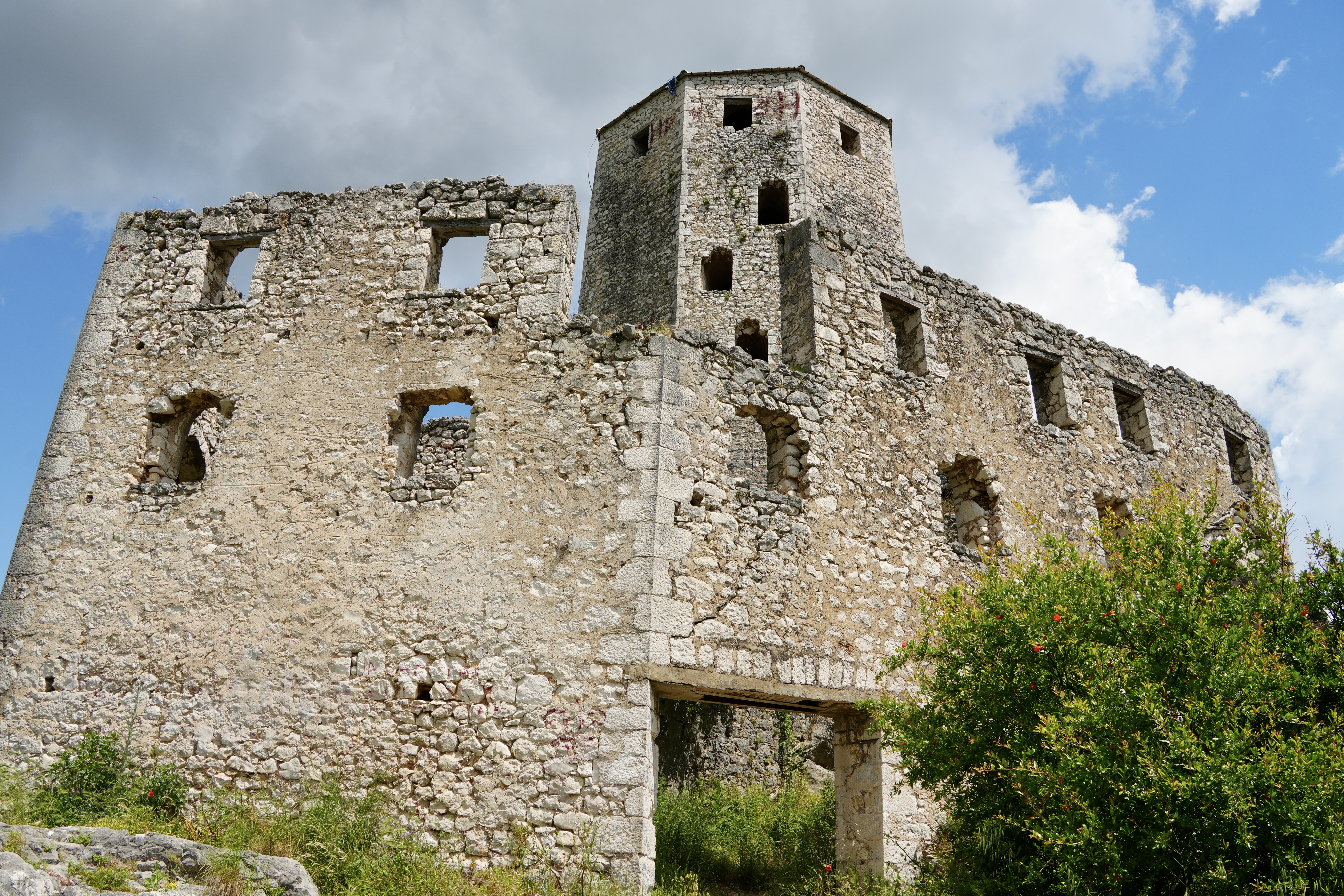
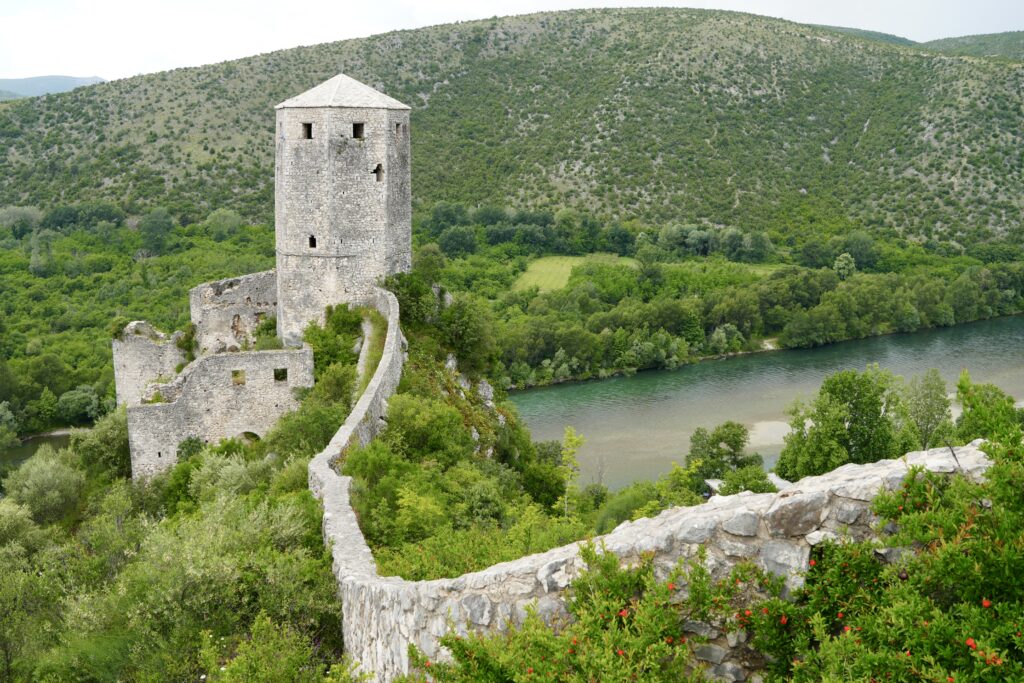
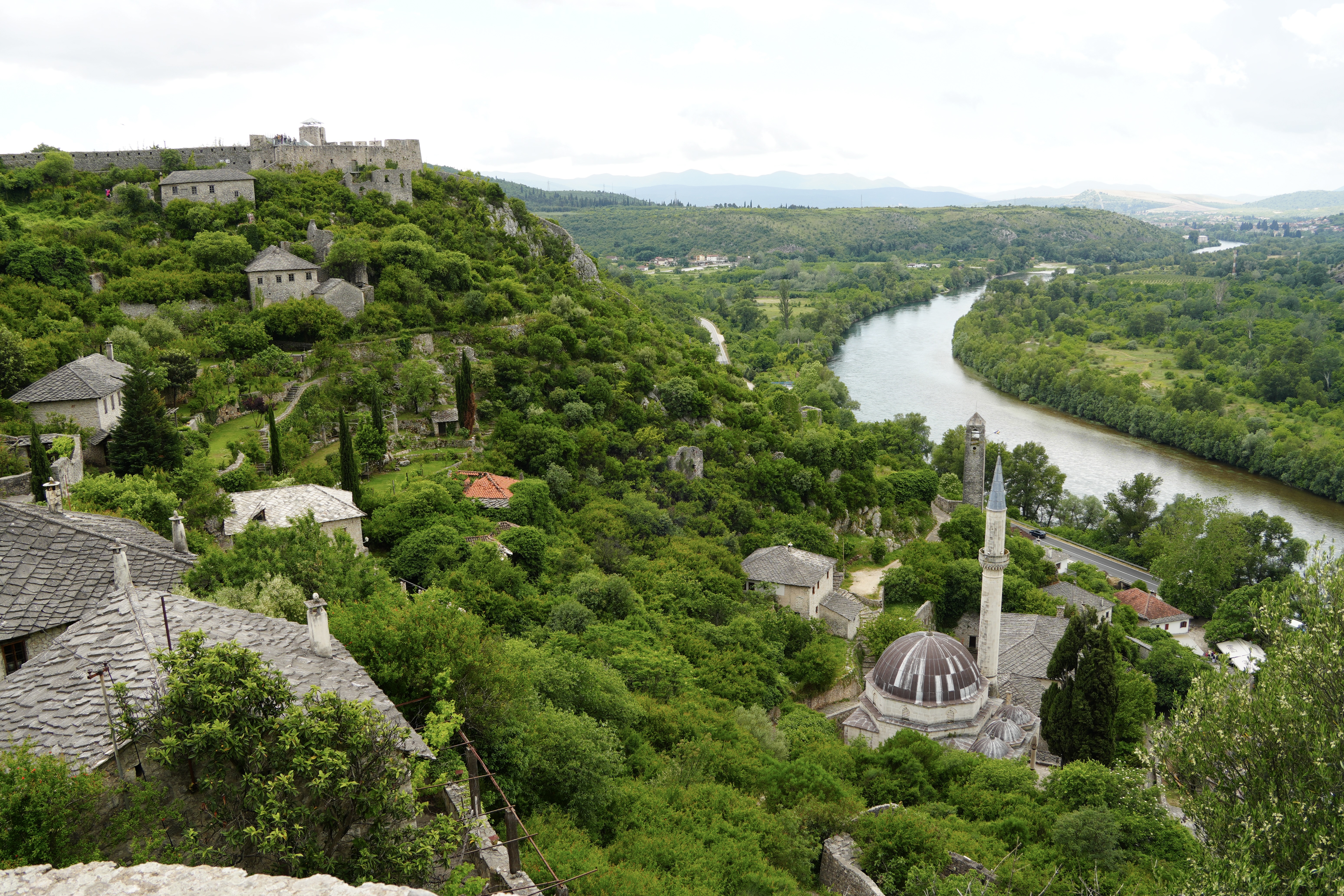
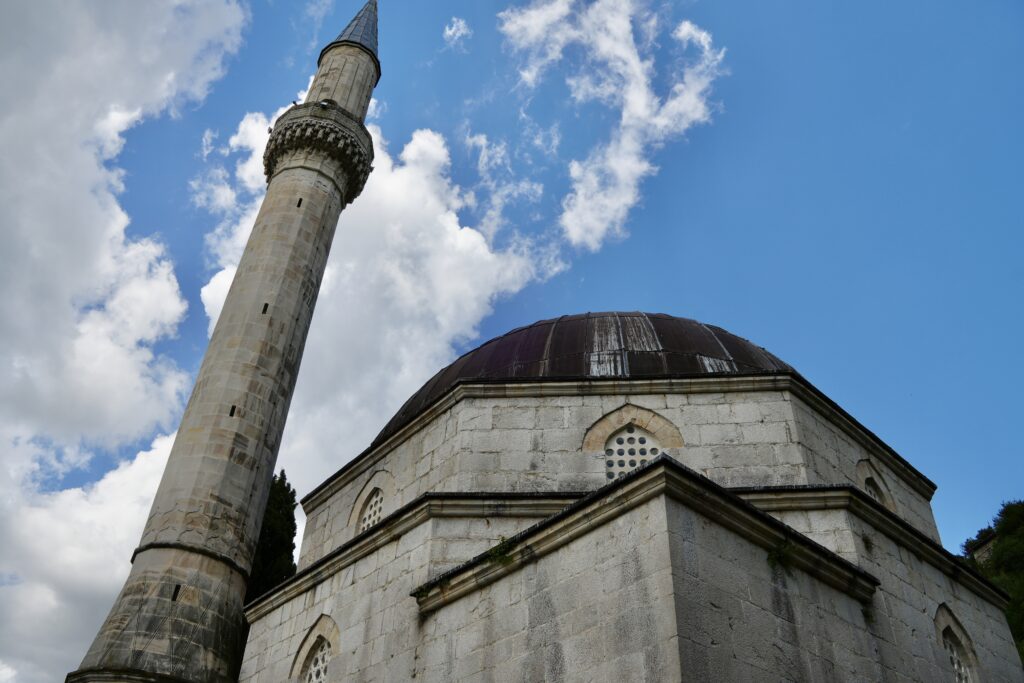
Final Thoughts
We really enjoyed our visit to Mostar. I think spending at least a couple days there if possible would be best to see the top sites with less crowds, enjoy some of the less visited areas, and go on a couple day trips. Mostar also has museums about the Bosnian Wars. We went to a couple war museums in Sarajevo, so we didn’t visit them in Mostar. If you are only visiting Mostar, going to a war museum would be a good addition to your itinerary.
I would have liked to add on a day trip to the nearby town of Blagaj to see its fortress and monastery. I also would have liked a hike into the hills around Mostar. Unfortunately I injured my left knee and was unable to walk for our last couple days in Mostar. This injury is still a problem as I write this blog, but we keep trying to see as much as we can as we journey on through more destinations. Next we head to the little town of Trebinje in southern Bosnia and Herzegovina.
If you are interested in hearing more about destinations in Bosnia and Herzegovina, check out my blog on Sarajevo and watch for an upcoming blog about Trebinje.
[…] If you enjoyed this post and want to hear about our other stops in Bosnia and Herzegovina, check out my other 2 blogs: Travel to Sarajevo in Bosnia and Herzegovina and Top Sites in Mostar. […]